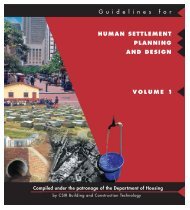Research and development for industry: Advanced ... - CSIR
Research and development for industry: Advanced ... - CSIR
Research and development for industry: Advanced ... - CSIR
Create successful ePaper yourself
Turn your PDF publications into a flip-book with our unique Google optimized e-Paper software.
AEROSPACE AND AUTOMOTIVE| 12 |Laser additive manufacturing:Building SA’s future one layer at a timeThe <strong>CSIR</strong> is developing a suite of unique laser additive manufacturing systems <strong>and</strong> processes that will place South Africaat the <strong>for</strong>efront of this technology, with tremendous potential benefits <strong>for</strong> the local manufacturing <strong>industry</strong>.Compared to conventionalmanufacturing technologies whichare often subtractive (materials areremoved via cutting or milling),additive manufacturing relieson various energy depositiontechnologies to fuse materialsinto three-dimensional functionalparts; materials are joined to makeobjects, one layer at a time. Laseradditive manufacturing (LAM)allows <strong>for</strong> this to be done usinglasers.This emerging manufacturingtechnology lends itselfto the <strong>development</strong> ofcomponents from uniqueceramic, alloy <strong>and</strong> light metalmaterials. It will be key inthe beneficiation of SouthAfrica’s titanium resources– around which ef<strong>for</strong>ts arebeing accelerated to establisha titanium <strong>industry</strong> – <strong>and</strong>af<strong>for</strong>ds the local aerospace<strong>industry</strong> a significantcompetitive advantage overinternational competitors.This innovative technologywill be used <strong>for</strong> the productionof unique finished goods<strong>for</strong> the aerospace, defence,automotive (in areas such asmotor racing) <strong>and</strong> medicalindustries. It is against thisbackdrop that the <strong>CSIR</strong> hascreated a programmefocusing specifically onadditive manufacturing.The goal of the additivemanufacturing programmeis to promote <strong>and</strong>advance the knowledge,capabilities, <strong>and</strong> economicopportunities in this field<strong>for</strong> the benefit of localindustries. To achievethis objective, the <strong>CSIR</strong>will focus its resources onsupporting three maininitiatives in additivemanufacturing.Deputy Minister of Science <strong>and</strong> Technology, Derek Hanekom, third right, recently officiated at the launch of a new additive manufacturing facility at the <strong>CSIR</strong>. Also present were, fromleft, Dr Paul Potgieter, group managing director: Aerosud; Dr Federico Sciammarella, manager of laser materials processing, <strong>CSIR</strong>; Dr Ndumiso Cingo, manager of the <strong>CSIR</strong> National LaserCentre; Dr Sibusiso Sibisi, chief executive officer, <strong>CSIR</strong>; <strong>and</strong> Dr Hoffie Maree, group executive: operations, <strong>CSIR</strong>.Laser metal depositionadditive manufacturing(current state-of-the-arttechnology)During 2012, the <strong>CSIR</strong>will establish an additivemanufacturing workgroup,focusing on laser-engineerednet-shaping (LENS) technology,with academia, <strong>industry</strong> <strong>and</strong>relevant government agencies.“LENS technology uses a highpowerlaser (500 W to 4 kW)to fuse powdered metals intofully dense, three-dimensionalstructures,” says Dr FedericoSciammarella, manager of lasermaterials processes at the <strong>CSIR</strong>.“The LENS three-dimensionalsystem uses the geometricin<strong>for</strong>mation contained in acomputer-aided design solidmodel to automatically drive theLENS process as it builds up acomponent, layer by layer,” henotes.Additional software <strong>and</strong> closedloopprocess controls ensurethe geometric <strong>and</strong> mechanicalintegrity of the completed part.The goal is to identify criticalcomponents <strong>and</strong> industries,in addition to the identifiedtarget markets in aerospace<strong>and</strong> biomedics, that can benefitfrom either manufacturing orrefurbishment/repair usingLENS technology. The <strong>CSIR</strong>will be a key link <strong>and</strong> driverin coordinating <strong>and</strong> <strong>for</strong>gingpartnerships of potential users.High-speed, large-areaselective laser melting(cutting-edge technology<strong>development</strong>)In a second project, called‘Aeroswift’, the <strong>CSIR</strong> hasteamed up with Aerosud, anestablished leader in the SouthAfrican aviation <strong>industry</strong>.The main goal of this projectis to establish a functionalfirst-generation, high-speed,large-area selective lasermelting system that will becapable of building aerospacecomponents with dimensionswithin a range of 2 m by0.5 m. Such a system iscurrently not availablecommercially <strong>and</strong> there<strong>for</strong>ewill have a niche marketwith high impact, as thereare a variety of aerospacecomponents that fall withinthese dimensions. Creatingthis technology in South Africain collaboration with theTitanium Industry Initiativewill contribute to South Africaincreasingly becoming a keyplayer in the aerospace sector.Major aerospace companieshave indicated that they arepaying close attention tothe success of this project,with 2016 targeted <strong>for</strong> a fullyoperational system, capableof producing its first parts.This would be a tremendousboost to the manufacturingsector in South Africa <strong>and</strong>would allow companies likeAerosud to exp<strong>and</strong> theirproduct range. It would alsosee South Africa cover thefull value chain from a rawproduct (titanium powder)to high-value components.Ultra-high-speed laseradditive manufacturing(next-generation, radicaldesign technology<strong>development</strong>)For the third project, called‘Umuvi’, the long-termobjective is to create futuregeneration high-speed,large-area, laser additivemanufacturing systems,to stay ahead of the trendworldwide <strong>and</strong> capture futurerevenue streams by meeting<strong>Research</strong>ers <strong>and</strong> engineers from the <strong>CSIR</strong> National Laser Centre <strong>and</strong> Aerosud have teamedup <strong>for</strong> project Aeroswift. They are working to create a functional first-generation, highspeed,large-area selective laser melting system that will be capable of building aerospacecomponents with dimensions within a range of 2 m by 0.5 m.future dem<strong>and</strong>s <strong>for</strong> moreefficient <strong>and</strong> higher productivitysystems.“The underpinning technology<strong>for</strong> all these projects is laserenabledadditive manufacturing<strong>and</strong> our LENS system will setthe tone <strong>for</strong> the Aeroswift <strong>and</strong>Umuvi projects. The systemenables immediate entry intothe refurbishment market,where worn-out parts orcomponents are repaired, <strong>and</strong>the working life or per<strong>for</strong>manceof the component becomeseven better, compared tothe original part,” saysSciammarella. “If we succeedin showing the value of thistechnology, projects Aeroswift<strong>and</strong> Umuvi will be welcomedby <strong>industry</strong>,” he adds.“Successful completion of theseinitiatives will see the creationof a knowledge base <strong>and</strong>capacity that will enable SouthAfrica to generate sustainablewealth <strong>and</strong> future opportunitiesin additive manufacturing,”concludes Sciammarella.Also read the article onpage 84.Enquiries:Dr Federico Sciammarellafsciammarella@csir.co.zaumuviUmuvi is an IsiZulu word<strong>for</strong> wasp: A winged insectthat has a narrow waist<strong>and</strong> a sting. It constructsa nest from wood pulp ormud, pictured above (usingthe principles of additivemanufacturing, left).| 13|
















